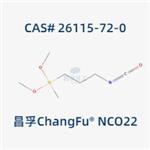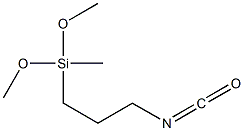The introduction of Silane, (3-isocyanatopropyl) dimethoxymethyl
General description
The Silane, (3-isocyanatopropyl) dimethoxymethyl, with the CAS No: 26115-72-0, is also known as γ-isocyanatopropylmethyl dimethoxysilane. This chemical’s molecular formula is C7H15NO3Si and molecular weight is 189.28. Its boiling point is 193.9±23.0 °C (Predicted), and its density is 0.96±0.1 g/cm3 (Predicted). The Silane, (3-isocyanatopropyl) dimethoxymethyl is a kind of coupling agent. Its structure is as follows:

Figure 1 Structure of Silane, (3-isocyanatopropyl) dimethoxymethyl
Chemical synthesis of Silane, (3-isocyanatopropyl) dimethoxymethyl
In the traditional preparation methods, Silane, (3-isocyanatopropyl) dimethoxymethyl is mainly synthesized by phosgene method and thermal cracking method. However, phosgene is too active and dangerous, and it is difficult for ordinary silane manufacturers to involve phosgene as raw material; The thermal cracking method mainly uses the reaction between aminosilane and diethyl carbonate and diamine carbonate. This process needs to be carried out by pyrolysis of carbamate at high temperature, so it consumes a lot of energy and requires strict production equipment and process requirements [1]. The Silane, (3-isocyanatopropyl) dimethoxymethyl can be synthesized by single step according to the previous work [1]. Briefly, 1045 g of a methylene diphenyl diisocyanate mixture of 50 wt% 2,2'-methylene diphenyl diisocyanate, 48.5 wt% 2,4'-methylene diphenyl diisocyanate and 1.5 wt% 4,4'-methylene diphenyl diisocyanate (Desmodur→ 21AI69, commercial product of Bayer Material Science AG, Leverkusen, DE, NCO-content: 32 wt%, HC content: 25 ppm) was placed in a four-necked flask (2000 ml) with nitrogen connection, stirrer, dropping funnel and distillation apparatus with a short column, the mixture was placed under nitrogen and heated to 120°C. At the same temperature, 209 g of aminopropylmethyldimethoxysilane (A2110, commercial product of GE Advanced Materials, Wilton, USA) was added into the flask, so that the reactor inner temperature was not increased above 130°C. After completion of the aminosilane addition, the flask internal temperature was adjusted to 160°C and carefully evacuated. The mixture began to boil at about 30 mbar and the isocyanatosilane was distilled over. During the distillation, the vacuum was slowly increased to 2 mbar and the temperature was slowly increased to 170°C until the end. After completion of the distillation, the apparatus was flushed with nitrogen and the bottom was covered in a tin can at 120°C. Yield: 201 g of Silane, (3-isocyanatopropyl) dimethoxymethyl (equivalent to 90% of theory) NCO content: 20.8 wt% Appearance: clear, colorless liquid. Viscosity biuret bottom: 19.000 mPas/70°C.

Figure 2 Chemical synthesis of Silane, (3-isocyanatopropyl) dimethoxymethyl.
Application of Silane, (3-isocyanatopropyl) dimethoxymethyl
The Silane, (3-isocyanatopropyl) dimethoxymethyl coupling agent is a special silane coupling agent, which can be widely used in the field of polymer materials such as adhesives, resin structure improvement of polyurethane materials, and can effectively improve the adhesive force of the resin, and enhance the adhesive force of the plastic or metal substrate with low surface tension [2]. Silane, (3-isocyanatopropyl) dimethoxymethyl contains isocyanate groups that can participate in the reaction and siloxane groups that can be cured by moisture. Therefore, it is more and more used in the polymer field to improve the adhesion ability of coatings, adhesives and other products to walls, cars and other interfaces. With the increasing requirement of environmental protection, the resin with this type of silane can be cured without adding additional catalyst. Silane terminated polyether resin and polyurethane resin are good examples [3].
Issues of Silane, (3-isocyanatopropyl) dimethoxymethyl
The Silane, (3-isocyanatopropyl) dimethoxymethyl contains unsaturated bonds and has high reactivity. It is easy to react with some organic or inorganic substances with active groups. Under the condition of being heated or having alkaline substances such as amino or hydroxyl groups, it is easy to undergo self-polymerization exothermic reaction and generate polymer polymers such as dimers or polymers. In the process of distillation and purification of conventional crude products containing Silane, (3-isocyanatopropyl) dimethoxymethyl coupling agent, it is difficult to avoid bringing in other active impurity groups. Under the heating of distillation, the isocyanate group double bond addition reaction or polymerization reaction is easy to occur, resulting in a large amount of distillation residue and affecting the yield of distillation products [3].
References
[1]Ludwig et al. Procedure for the production of isocyanatoalkylsilanes from MDI and aminoalkylsilanes. Ger. Offen., 102004040220, 02 Mar 2006.
[2]Yang et al. Purification method of isocyanato silane coupling agent. CN 112062786, 11 Dec 2020.
[3]Jiang et al. γ-Isocyantopropylsilane and preparation method thereof. CN 109438501, 08 Mar 2019.
Related articles And Qustion
See also
Lastest Price from Silane,(3-isocyanatopropyl)dimethoxymethyl manufacturers

US $10.00/KG2025-04-21
- CAS:
- 26115-72-0
- Min. Order:
- 1KG
- Purity:
- 99%
- Supply Ability:
- 10 mt

US $0.00-0.00/kg2025-04-18
- CAS:
- 26115-72-0
- Min. Order:
- 0.10000000149011612kg
- Purity:
- 96%
- Supply Ability:
- 800tons



